Related Research Articles
A by-election, also known as a special election in the United States and the Philippines, or a bypoll in India, is an election used to fill an office that has become vacant between general elections.

The 2004 Canadian federal election, was held on June 28, 2004, to elect members of the House of Commons of Canada of the 38th Parliament of Canada. The Liberal government of Prime Minister Paul Martin lost its majority, but was able to form a minority government after the elections. The main opposition party, the newly amalgamated Conservative Party of Canada, improved its position but with a showing below its expectations.

The 1988 Canadian federal election was held November 21, 1988, to elect members of the House of Commons of Canada of the 34th Parliament of Canada. It was an election largely fought on a single issue: the Canada–United States Free Trade Agreement (FTA).
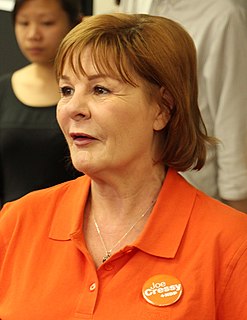
Irene R. Mathyssen is a Canadian politician and was a Member of Parliament in the House of Commons of Canada from 2006 until 2019. She was previously a New Democratic Party Member of Provincial Parliament (MPP) in Ontario from 1990 to 1995, and briefly served as a minister in the government of Premier Bob Rae.

Labrador is a federal electoral district in Newfoundland and Labrador, Canada, that has been represented in the House of Commons of Canada since 1949.

Ottawa Centre is an urban federal electoral district in Ontario, Canada, that has been represented in the House of Commons of Canada since 1968. While the riding's boundaries have changed over the years to account for population changes, the riding has always comprised the central areas of Ottawa, the nation's capital.

The 2006 Canadian federal election was held on January 23, 2006, to elect members of the House of Commons of Canada of the 39th Parliament of Canada. The Conservative Party won the greatest number of seats − 40.3% of seats, or 124 out of 308, up from 99 seats in 2004 — and 36.3% of votes, up from 29.6% in the 2004 election.
Canadian federal elections have provided the following results in Newfoundland and Labrador.
This article provides the timeline of the 2006 Canadian federal election, which was called on November 29, 2005 when the Governor General dissolved parliament following the government's defeat in a motion of no confidence. The election was held on January 23, 2006.

The 39th Canadian federal election was held on January 23, 2006.

Anything But Conservative, also known as the ABC campaign and Vote ABC, is a political campaign whose aim is to defeat the Conservatives in Canadian federal elections. It encourages strategic voting.
This article covers the history of the New Democratic Party of Canada.
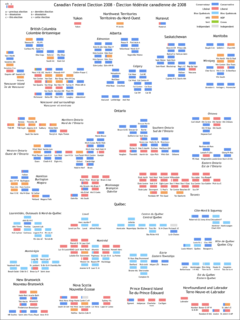
The 40th Canadian federal election was held on October 14, 2008.
By-elections to the 37th Canadian Parliament were held to fill vacancies in the House of Commons of Canada between the 2000 federal election and the 2004 federal election. The Liberal Party of Canada led a majority government for the entirety of the 37th Canadian Parliament, with little change from by-elections.
By-elections to the 40th Canadian Parliament were held to fill vacancies in the House of Commons of Canada between the 2008 federal election and the 2011 federal election. The Conservative Party of Canada led a minority government for the entirety of the 40th Canadian Parliament, with little change from by-elections.
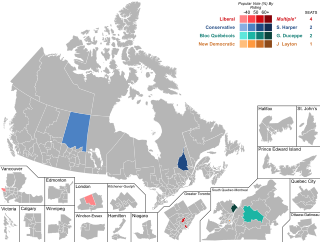
By-elections to the 39th Canadian Parliament were held to fill vacancies in the House of Commons of Canada between the 2006 federal election and the 2008 federal election. The Conservative Party of Canada led a minority government for the entirety of the 39th Canadian Parliament, though did increase their number from by-elections.
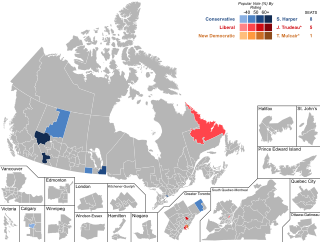
By-elections to the 41st Canadian Parliament were held to fill vacancies in the House of Commons of Canada between the 2011 federal election and the 2015 federal election. The 41st Canadian Parliament existed from 2011 to 2015 with the membership of its House of Commons having been determined by the results of the Canadian federal election held on May 2, 2011. The Conservative Party of Canada had a majority government during this Parliament.
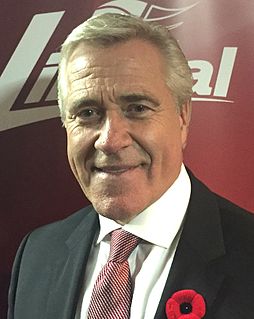
The 2015 Newfoundland and Labrador general election, held on November 30, 2015, elected members of the House of Assembly in the Canadian province of Newfoundland and Labrador. The Progressive Conservative Party which had governed since 2003 election, was defeated by the Liberal Party, which won a majority in the new assembly.
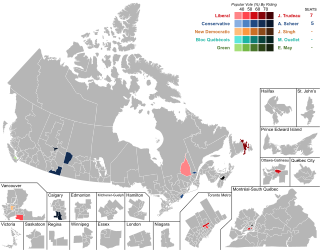
By-elections to the 42nd Canadian Parliament were held to fill vacancies in the House of Commons of Canada between the 2015 and the 2019 federal elections. The 42nd Canadian Parliament existed from 2015 to 2019 with the membership of its House of Commons having been determined by the results of the Canadian federal election held on October 19, 2015. The Liberal Party of Canada had a majority government during this Parliament.

A by-election was held in the federal riding of South Surrey—White Rock in British Columbia on December 11, 2017 following the resignation of Conservative MP Dianne Watts. The seat was gained for the Liberals by Gordie Hogg.
References
- "Labrador By-election on May 24, 2005 – Elections Canada". Elections Canada On-line. 2005-05-24. Retrieved 2021-05-05.
- "Profile - 2005-05-24". Library of the Canadian Parliament. 2005-05-24. Retrieved 2021-05-05.